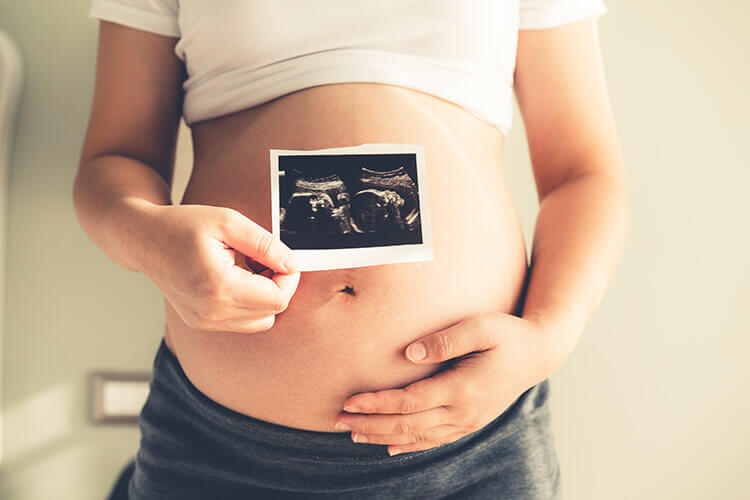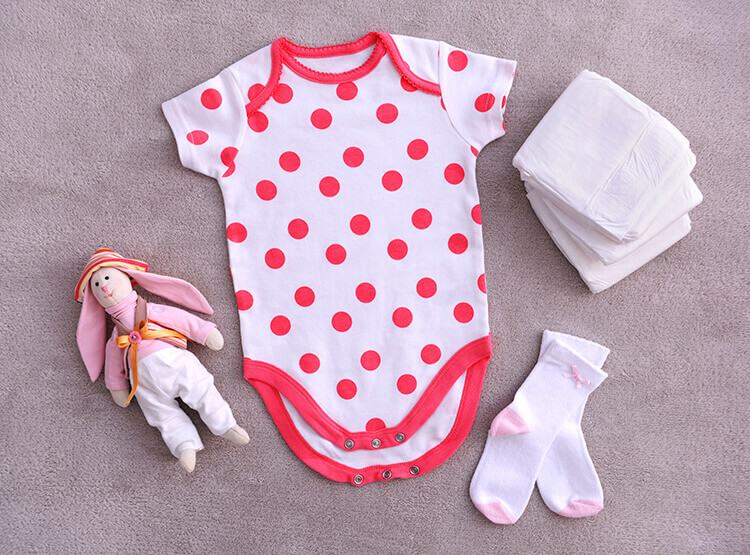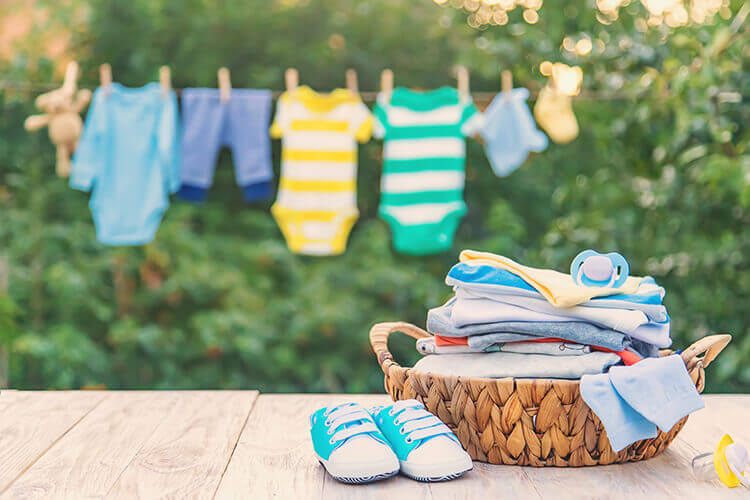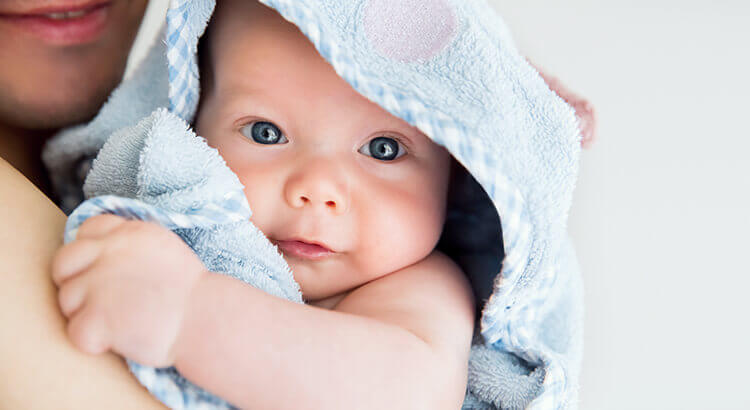
Save money
Waste not, want not. Find out how you can save money and cut down on your household waste at the same time.
Posted on: November 22, 2019
Wondering how to keep your waste in check with a new baby? We can help!
Today, having a kid often results in an avalanche of 'stuff' – nappies, wipes, bottles, sippy cups, clothes, bedding, bassinets, cots, baby capsules, car seats, carriers, prams, bouncers, toys… And a lot of that stuff ultimately winds up in landfill, creating a lasting impact. But with a bit of 'green thinking', you can reduce your waste impact and also set your kids up to be the waste warriors of the future.

A new arrival doesn’t have to be an exercise in excess consumerism.
So many baby items are only used or worn a handful of times and then outgrown. Shopping second-hand makes complete sense for this reason – you’ll still be able to get cute and good quality stuff but your budget will stretch so much further and you’ll be keeping items out of landfill.

New doesn’t mean better! Save yourself a trip to the shops – see what you can source second-hand on gumtree, local swap, sell, buy and give groups and at markets first
Look out for baby markets in your local area, join a buy and sell group, or set up a Gumtree search – you’ll quickly see that there are an abundance of options out there when it comes to cots, strollers, clothing, bedding and toys. Your local op shops might also be worth a look too, especially for books and toys.
Say “yes please” to hand-me-downs too if friends and family offer and remember that hiring is also an option for many of the more expensive items that you are unlike to use for long periods of time (for example breast pumps and newborn capsules / car seats).
Still not convinced? Keep reminding yourself that all babies and toddlers need is love, food and basic clothing to thrive, they have no concept of the newness of their furniture, the variety in their wardrobe or the value of a pristine set of expensive toys.
When it comes to having a baby there’s a lot of talk about needing to deck out a nursery with every gadget known to man before the child arrives… but here’s a secret…you don’t need most of it!
That’s right, now that we’ve got you thinking about sourcing your baby stuff second-hand, we’re going to suggest that you hold off buying almost everything until you have a genuine need for it.

Work out what you really need before you open your wallet.
So long as there is somewhere for the baby to sleep (and remember, in Scandinavia many newborns sleep in a recyclable cardboard box) when you get home from the hospital and a couple of outfits for them to wear you’ll be fine.
Give yourself the chance to get into the parenthood groove and then work out what might be useful to have. You’ll also find that many people will come bearing practical gifts (and hand-me-downs) once the baby arrives.
When you do need to buy items (and are unable to shop second-hand first) think about how you can make lower-waste purchasing decisions. Consider what things are made from – remember that cotton, linen, wool and wood are all biodegradable materials, whereas synthetic materials and plastic items are not).
Disposable nappies may be convenient but they also generate vast amounts of waste. A baby will typically go through between 4,000 and 6,000 nappies before they are toilet-trained - that’s more than 2 tonnes of soiled plastic heading to landfill for the next few hundred years.

Choose to cloth nappies to avoid sending an extra two tonnes of plastic waste to landfill.
Modern cloth nappies are reusable (buy once, use over and over) and will keep all those smelly plastic bundles out of your kerbside waste bin. They’ll also cost you a lot less. For example, a stash of cloth nappies will cost around $500 - $1,000 (depending on the type you choose and how frequently you want to wash). You’ll need to spend a whopping 3-to-6 times as much (circa $3,000) if you use disposables from birth until a child no longer needs them.
The cloth nappies of today are a far cry from those terry cloth squares and safety pins your parents and grandparents used. Modern reusable cloth nappies fit well, are made from breathable, natural fibres (good for bub’s skin and with no nasty chemicals), and available in a range of funky colours and cute prints. And they’re easy to care for – no need to soak, just pop them in the wash. Worried about the extra water, energy use and detergents doing the washing? Reusables are still a more environmentally-friendly choice if they aren’t being soaked and are line-dried.
You may still need the convenience of a disposable nappy at some point so if you do opt for the biodegradable ones (but remember they will still take a decade to breakdown and should only ever be placed in your general waste bin!).
Single-use wet wipes might seem like an ideal-go to but what a lot of people don’t realise is that they typically contain plastic so, like disposable nappies, they too will still be sitting in landfill when that little baby’s baby has babies!

Rather than use throw-away wipes, invest in a reusable set that you can pop through the washing machine with other items.
Biodegradable bamboo wipes can be a better alternative, but the impact-owning choice is always going to be finding something you can reuse.
Try using small face cloths with a home-made spray for cleaning during nappy changes, or re-fashioning fabrics that you already have around the home like old t-shirts. Give them a quick rinse when you’re done and pop them in the wash.
Although there are wonderful natural skincare products available for babies, most come in plastic packaging. But you don’t need to buy fancy lotions and potions for baby. You can keep it simple and low impact and still keep baby’s skin soft and healthy.

Less is best when it comes to baby’s skincare routines. Seek out package-free, mild soaps and moisturise with oils.
Wash bub’s skin with a mild bar soap, such as olive oil or chamomile, which can be purchased package-free at your local health food store. Moisturise and treat nappy rash with coconut oil or olive oil, which can be bought in glass jars or in reusable containers at some bulk food stores.
Once bub is on solids, look at making your own baby and kid-friendly snacks and meals.
It’s not only cheaper, you’ll know exactly what’s in it and be able to adapt the recipe to suit your little one’s preferences. Most importantly though, you’ll be cutting down on excessive packaging

Making your own baby food means less waste and total control over the ingredients list.
Buy – or better still, grow – most of the ingredients you need for meals. Whizz fresh produce up in a blender and store them in air-tight glass jars in the fridge. Or get ahead, batch cook and freeze portions in ice-cube containers.
When it comes to snacking items invest in some small reusable containers and a good drink bottle in order to avoid reliance on on individually wrapped snacks yoghurt pouches, and silver-lined juice boxes.
And if you have any time or energy left… don’t forget to compost food scraps. Once your little one is toddling and older, they’ll probably love helping you with the worm farm, chicken coop or composting.
One easy way to reduce your impact as a new parent, while still giving your child access to lots of opportunities, is to look at becoming a member at your local library.
It’s more than just having access to truckloads of books and fostering a love of reading. Modern libraries can be a great outing destination for new parents too - join in the Baby Rhyme Time sessions, encourage interaction with other children in the toy and puzzle corners many have, or find a quiet spot and take solace in flicking through the latest issue of your favourite magazine while your baby naps.
While you’re flexing your membership muscles, it’s also worth finding out if there’s a toy library in your local area – for a small fee you’ll be able to keep little ones delighted with a constantly evolving collection of new toys. You can read more about toy libraries and why they make sense in this article.
In Australia, the biggest generators of household waste are households with children. Your small changes do make a difference and will set a great example for your child. Share your best tips for low waste parenting with us at any time!

Waste not, want not. Find out how you can save money and cut down on your household waste at the same time.

When putting out the bins across Perth and the South West, a fancy new word has been added to bin night conversation – “FOGO”.

Never part with a favourite pair of jeans prematurely again with this great hack to help bring faded items back to life.